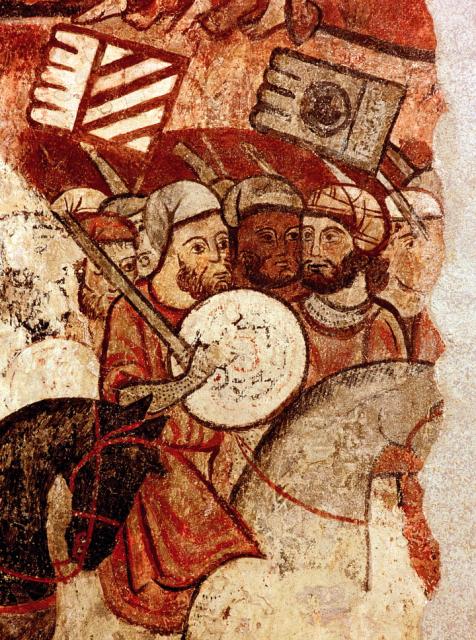There was a parallel development of light cavalry at opposite ends of Europe which reached its height as the 16th century began.
The roots were, of course, far older. In the East, there was the steppe tradition which had come into Hungary and its neighbours many times. As Hungarian society changed, the number of locals who could provide skilled light cavalry began to decline. However certain regions and sections of society maintained their traditions for longer, in part due to the influence of the Tartars to the east and increasingly the Ottomans to the south.
These are QR Miniatures from their Polish late 16th century range. They look very similar to the illustrations of Hungarian horse archers from the late 15th/ early 16th century in the Army of King Matthias so I have used them for these. A couple in the pack are armed with firearms so I have not used those. Others have cartridge boxes on their backs which I could have tried carving away but they are easily overlooked.
These are QR Miniatures Serbians. Serbian cavalry entered Hungarian and then Polish service as their homeland was occupied by the Ottomans. Their style influenced the local cavalry, with the use of a lance being emphasised instead of a bow or crossbow. One of the theories for the origin of the word 'Hussar' is that it comes from Serbian. Over time, 'Serbian' may even have been a description of the style of cavalry rather than being a reliable indicator of the origin of all the men.
The figures seem to have been based very much on the Polish hussars in the Battle of Orsha painting*. Link has a number of close ups - I've shown a detailed view of the hussars at the head of this page. Also in the painting are similarly dressed figures who have bows as well as lances. They are likely Lithianians, though the green flag may originally have been blue.
The flag I have given them is Hungarian from here - it was a style carried at Mohacs in 1526.
These are some of my favourite figures.
These are some figures from the 'By Fire and Sword' range. Again, they are intended for a later period than I am modelling, so some have holsters on their horses. A bit of chopping and painting soon hides them though. These are from the 'Transylvanian' range. Most are actually sold as Szekelers so that is what I am using them as. They are quite similar to the Hungarians shown in the Babenberg family tree. I wonder if the blue trousers are significant - they seem to be increasingly a feature of Hungarian military wear until they became a standard part of the uniform in the 18th century.
These figures would probably work as Moldavians and Wallachians as well, and perhaps Lithuanians if they are not as dolled up as the ones in the Orsha painting.
A comparison shot of the QR Serbians with BFaS Szekelers. Since they are likely to be unfamiliar to many, I've put a comparative Essex element next to them.
Apart from the comparative Essex figures, these are Stradiots - those in the centre element are from Venexia, those on the right are Mirliton. All the Stradiots are mounted on Vexillia horses - some have had the Eastern style rump covers added.
Stradiots were recruited by the Venetians in their territories across the Adriatic. They were initially Albanians though their name is probably Greek. This has a selection of pictures of Stadiots and Hussars - there is often argument about which are represented in certain pictures.
For a while, the Venetians paid them according to the number of heads taken (see Commynes), so some of the horses have Xyston severed heads hanging from the saddle.
More stradiots and/or hussars can be found in Maximilian's Weiss Kunig including plates 75, 77, 82 and 83.
The role of stradiots and Albanians in war can be seen in various contemporary histories such as Chalkokondylas, Bembo and Commynes
The role of stradiots and Albanians in war can be seen in various contemporary histories such as Chalkokondylas, Bembo and Commynes
Most of Western Europe used little or no light cavalry for most of the Medieval period. The main exception was in Iberia. The conditions, the Morish influence and the availability of suitable horses meant that the use of light cavalry continued through the reconquest and beyond.
These are mostly Donnington New Era figures from the new Islamic range and I really like them. There has been a lot of attention to detail, using mostly Ian Heath's pictures I think. These in turn are based largely on the 'Conquest of Majorca' and the 'Cantigas de Santa Maria' . There are many other examples here.


Berber horsemen continued to look very similar over the next centuries as can be seen in the Conquest of Oran.
The same picture shows how the Christian Spanish had changed by this time.
This shows the Essex Andalusian horse next to jinetes of the 14th century and some from the late 15th/early 16th. Even by the 14th century the equipment had become heavier. The middle figures are by Alain Touller, those on the left by Venexia (though on Vexillia horses). Both ranges are unfortunately OOP. [Update: Venexia are available from Lancashire Games. Vexillia are now OOP though].
*Watchers of BBC's Being Human may remember that Orsha was where Hal made his, umm, lifestyle choice.
_10.jpg)








2 comments:
Ah! So this is what you wanted all those horses for. Nice work and a useful article.
Indeed. Quite a few left for the Mirliton Hungarians too, which will get done one day.
Post a Comment